Potřebujeme váš souhlas k využití jednotlivých dat, aby se vám mimo jiné mohly ukazovat informace týkající se vašich zájmů. Souhlas udělíte kliknutím na tlačítko „OK“.
ASTM E2257-13a
Standard Test Method for Room Fire Test of Wall and Ceiling Materials and Assemblies (Includes all amendments And changes 3/11/2016).
Automaticky přeložený název:
Standardní zkušební metoda pro místnosti Fire Test na stěny a strop Materiály a shromáždění
NORMA vydána dne 1.8.2013
Informace o normě:
Označení normy: ASTM E2257-13a
Poznámka: NEPLATNÁ
Datum vydání normy: 1.8.2013
Kód zboží: NS-44825
Počet stran: 20
Přibližná hmotnost: 60 g (0.13 liber)
Země: Americká technická norma
Kategorie: Technické normy ASTM
Kategorie - podobné normy:
Anotace textu normy ASTM E2257-13a :
Keywords:
carbon dioxide, carbon monoxide, corner, fire, fire-test response, flame, heat release, heat release rate, ignition, optical density, oxygen consumption calorimetry, room, smoke obscuration, toxic gases, ICS Number Code 13.220.50 (Fire-resistance of building materials and elements)
Doplňující informace
| Significance and Use | ||||||||||||||||||
|
5.1 This fire test is applicable to a description of certain fire performance characteristics in appraising wall and ceiling materials, products, or systems under specified fire-exposure conditions in an enclosure. The test indicates the maximum extent of fire growth in a room, the rate of heat release, and if they occur, the time to flashover, and the time to flame extension beyond the doorway following flashover. It determines the extent to which the wall and ceiling materials or assemblies contribute to fire growth in a room and the potential for fire spread beyond the room, under the particular conditions simulated. It does not measure the contribution of the room contents. (See 5.1.1 The potential for the spread of fire to other objects in the room, remote from the ignition source, is evaluated by measurements of: (a) the total heat flux incident on the center of the floor, and (b) a characteristic upper level gas temperature in the room. 5.1.2 The potential for the spread of fire to objects outside the room of origin is evaluated by the measurement of the rate of heat release of the fire. 5.1.3 Measurements of the rate of production of carbon monoxide, carbon dioxide, and visible smoke are taken. 5.1.4 The overall performance of the test specimen is visually documented by full-color photographic records. Video taping of the complete fire test is an acceptable alternative to the photographic record. Such records show when each area of the test specimen becomes involved in the fire. 5.2 In this procedure, the specimens are subjected to a specific set of laboratory fire test exposure conditions. If different test conditions are substituted or the anticipated end-use conditions are changed, it is not known whether it is possible by use of this test to predict changes in the performance characteristics measured. Therefore, the results are strictly valid only for the fire test exposure conditions described in this procedure. |
||||||||||||||||||
| 1. Scope | ||||||||||||||||||
|
1.1 This is a fire-test-response standard. 1.2 This test method is intended to evaluate, under specified fire-exposure conditions, the contribution to room fire growth provided by wall or ceiling materials and assemblies, or both. The method is not intended to evaluate the fire endurance of assemblies or fires originating in the wall assembly. The method provides a means to evaluate the effectiveness of thermal barriers in restricting the contribution of combustible materials in the wall assembly to fire growth in a room fire. 1.3 This test method, simulating a fire in the corner of a 2420 by 3630 mm (8 by 12 ft) room containing a single open doorway, provides a means to evaluate the relative performance of specified wall and ceiling materials or assemblies when they are used together in the same relationship within an enclosure, and simulating the manner in which they will be used. 1.4 This test method is intended to evaluate the contribution to fire growth provided by a surface product using a specified ignition source. It shall, however, be noted that the type, position and heat output of the ignition source will considerably influence fire growth. The thermal exposure conditions from the ignition source specified in this method will result in flashover during the 20 min duration for many common finish materials, in particular if specimens are mounted on the walls and the ceiling (standard configuration). 1.5 This test method provides a means for evaluating wall and ceiling finish materials and assemblies, including panels, tiles, boards, sprayed or brushed coatings, etc. This test method is not intended to evaluate flooring materials or furnishings. 1.6 This method shall be used in conjunction with Guide E603, which covers instrumentation and the general effect of various parameters, and Guide E2067, which deals with full-scale oxygen consumption calorimetry. 1.7 The values stated in SI units are to be regarded as the standard. The units given in parentheses are for information only. 1.8 The text of this standard references notes and footnotes which provide explanatory information. These notes and footnotes (excluding those in figures) shall not be considered as requirements of the standard. 1.9 This standard is used to measure and describe the response of materials, products, or assemblies to heat and flame under controlled conditions, but does not by itself incorporate all factors required for fire-hazard or fire-risk assessment of the materials, products, or assemblies under actual fire conditions. 1.10 This standard does not purport to address all of the safety concerns, if any, associated with its use. It is the responsibility of the user of this standard to establish appropriate safety and health practices and determine the applicability of regulatory limitations prior to use. 1.11 Fire testing is inherently hazardous. Adequate safeguards for personnel and property shall be employed in conducting these tests. |
||||||||||||||||||
| 2. Referenced Documents | ||||||||||||||||||
|
Podobné normy:
Historická
1.11.2013
Historická
15.11.2011
Historická
15.1.2010
Historická
15.7.2012
Historická
1.10.2013
Historická
1.8.2012
Doporučujeme:
Aktualizace technických norem
Chcete mít jistotu, že používáte pouze platné technické normy?
Nabízíme Vám řešení, které Vám zajistí měsíční přehled o aktuálnosti norem, které používáte.
Chcete vědět více informací? Podívejte se na tuto stránku.


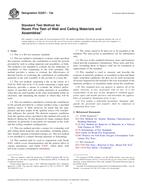
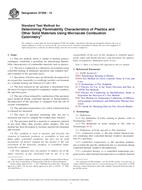 ASTM D7309-13
ASTM D7309-13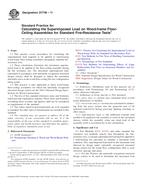 ASTM D7746-11
ASTM D7746-11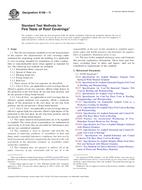 ASTM E108-11
ASTM E108-11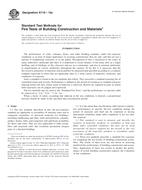 ASTM E119-12a
ASTM E119-12a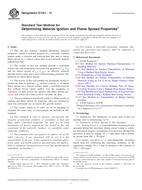 ASTM E1321-13
ASTM E1321-13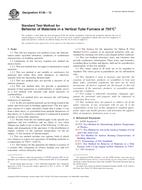 ASTM E136-12
ASTM E136-12
 Cookies
Cookies
